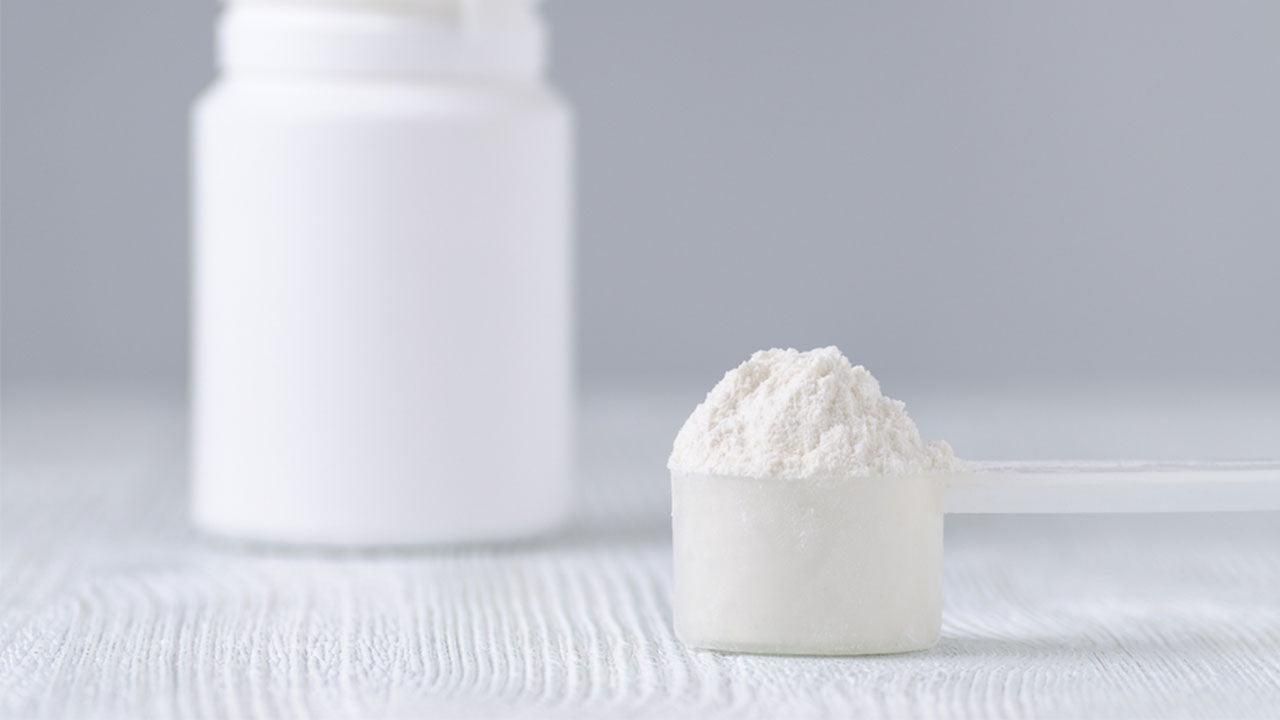What Are Nonpolar Amino Acids?
 By: by Amino Science
By: by Amino Science

Of the 20 common amino acids in the human body that build protein structures, 9 of them are essential (meaning we must eat or otherwise consume them to get them), and half of them are nonpolar. What are nonpolar amino acids? Which are they, and what does "nonpolar" mean? The review of the topic in this article will help explain.
The Definition of a Nonpolar Molecule
The nonpolar molecules we'll be talking about are hydrophobic amino acids, meaning "water fearing" because they don't mix with water molecules. You know how oil and water don't mix? That's because oil is hydrophobic.
The opposite of a nonpolar molecule is, as you might guess, polar. Polar molecules are hydrophilic, meaning "water loving." If you'd like to visualize: polar molecules are like puppy dogs who love water so much that they'll go barreling straight into muddy or smelly water after a tennis ball, with no hesitation at all. That would make nonpolar molecules like cats, better known for avoiding water, no thank you, and cleaning themselves without it.
Molecules are classified this way based on the charges on the atoms bonded together to form the molecule. If you remember your first taste of high school chemistry, you may remember that atoms have a nucleus of neutral neutrons and positive protons in the middle, and negative electrons swirling all around. Protons have a positive charge that draws electrons to it, like how opposites attract.
When two atoms bond together, they share electrons. Two atoms of the same element have equal positivity, so don't have the power to steal electrons from the other. These molecules are nonpolar because they have no resulting charge. When atoms of two different elements connect together, invariably one of them will have the higher charge and attract the most electrons to its end of the joint molecule. That means the molecule is polar, or charged, and that charge will then be identified as either a positive or negative charge.
Examples of Nonpolar Molecules
Methane gas is an example of a nonpolar molecule that is created during the breakdown of food and released as a gas (or more colloquially, a fart). Methane is made up of one carbon atom that is bound to four hydrogen atoms: this hydrogen bonding allows the atoms to all share electrons equally, so this smelly molecule has no charge and is nonpolar.
Inside our body, we have both polar and nonpolar molecules, which includes those 20 amino acids mentioned above.
Nonpolar Amino Acids

The chemical properties of amino acids are largely determined by one group of molecules, what's known as the R group: a side chain that differs on each amino acid. To visualize the amino acid groups, picture a pizza with four toppings, and a little support table in the middle that's there to keep the cheese from sticking to the lid. That table is the alpha carbon to which all the groups or toppings are attached.
Every amino acid has three groups/toppings in common: the amino group (-NH2), the carboxyl group (COOH), and a hydrogen atom, which in pizza terms would be three standard toppings, say pepperoni, sausage, and cheese (cheese is hydrogen, which is just one atom and not a group of them, and so it gets the plainest topping). That fourth quarter of the pizza? That is the R group, the functional group that identifies and characterizes different amino acids—when you think of the R group, think R for Radical, because that is a completely different and unique topping, and every R group amino acid side chain has a distinct flavor of its own. To get up to 20 it would have to be pineapple, spinach, olives, Canadian bacon, jalapeño, garlic, anchovies, bell pepper, salami, feta cheese, beef, oregano, bacon, barbecue sauce, chicken, pesto, chorizo, broccoli, eggplant, and mushroom. Some are weirder than others.
The nonpolar amino acids have R groups mostly made up of hydrocarbons, though the amino acids methionine and cysteine also each feature a sulphur atom. The nonpolar amino acids are as follows, with more information on each one.
Glycine
- Three letter code: gly
- One letter code: G
The body needs glycine to make compounds like as glutathione, creatine, and collagen, which is the most abundant protein in your body. Collagen is a vital part of your muscles, blood, skin, cartilage, ligaments, and bones. Glycine may also protect your liver from alcohol damage, contribute to heart health, and improve your sleep quality. Glycine might also protect those with type 2 diabetes from muscle-wasting. You can gain more glycine by eating certain meat products or by taking a collagen supplement.
Alanine
- Three letter code: ala
- One letter code: A
Alanine is an amino acid that helps convert glucose into energy and helps eliminate excess toxins from your liver. Alanine keeps muscle protein from being cannibalized by the body during intense aerobic exercise or activity, and it's needed to balance nitrogen and glucose levels in the body, which it does via the alanine cycle.
Alanine is a nonessential amino acid, which means that usually your body can make the substance on its own and doesn't need you to ingest it from outside. However, people with eating disorders, extremely low-protein diets, diabetes, liver disease, or certain genetic conditions that cause UCDs (urea cycle disorders), may need to take a supplement or adjust their diet to gain this amino acid.
Good sources of alanine are meat, fish, poultry, eggs, and dairy products, as well as some protein-rich plant foods, like avocado. There are supplements containing alanine on the market, however, taking any one amino acid alone could upset the balance of nitrogen in the body, putting stress on the liver and kidneys as they try to eliminate waste. It is advisable that those with liver or kidney disease should consult a trusted medical professional before taking any amino acid supplement.
Proline
- Three letter code: pro
- One letter code: P
Proline is needed for the manufacture of cartilage and collagen, which helps heal cartilage and cushion our joints and vertebrae. It keeps joints flexible, and skin supple when it is affected by sun damage or signs of normal aging. Proline breaks down proteins for cell creation, and is essential at sites of injury where the tissue must be rebuilt to heal. Proline supplementation is sometimes valuable to people with chronic back pain or osteoarthritis.
Proline is also needed for the maintenance of muscle tissue, and is sometimes found low in long-distance runners and other serious athletes. Proline is usually nonessential, as the body naturally derives proline from its supplies of glutamic acid. However, if necessary, proline can be found in natural sources like dairy, meat, and eggs, or can be gained from amino acid supplementation.
Valine
- Three letter code: val
- One letter code: V
Valine is a branched-chain amino acid (BCAA) that works with the other two BCAAs (isoleucine and leucine) to regulate blood sugar, repair tissues, and provide the body with energy. Valine assists in stimulating the central nervous system and is necessary for mental functioning. Valine helps provide muscles with extra glucose energy during intense physical activity, which prevents muscle breakdown, and helps remove toxic excess nitrogen from the liver. Valine may help the liver and gallbladder recover from damage due to alcoholism or drug abuse, as well as help possibly reverse alcohol-related brain damage, or hepatic encephalopathy.
Valine is an essential amino acid, and must be obtained through a diet including meats, mushrooms, dairy products, peanuts, and/or soy protein. Most people have no problem getting enough valine, however maple syrup urine disease or MSUD is caused by an inability to metabolize leucine, isoleucine, and valine. Supplementation is sometimes warranted in those with low-protein diets or who are trying to build muscle mass, but be advised that too much valine intake will make one's skin feel like it is crawling, and may cause hallucinations. Supplements should always be taken responsibly.
Leucine
- Three letter code: leu
- One letter code: L
Leucine helps with blood sugar regulation, muscle repair, and energy production. It also helps burn fat located deep inside the body that is hard to reach through diet and exercise alone.
Leucine is a branched-chain amino acid (BCAA) along with valine and isoleucine, all of which help to promote post-exercise muscle recovery, leucine being particularly effective, as it converts to glucose the fastest of the three. That is also why leucine is closely linked with the regulation of blood sugar, and why a leucine deficiency causes symptoms like hypoglycemia: headaches, fatigue, dizziness, confusion, depression, and irritability.
Leucine promotes the recovery of skin, bones, and muscle tissue after injury or surgery. Natural sources of this essential amino acid are meat, nuts, soy flour, brown rice, beans, and whole wheat.
Isoleucine
- Three letter code: ile
- One letter code: I
An isolated form of leucine, isoleucine is prized by bodybuilders for its ability to increase endurance, help repair muscle tissue, and encourage clotting at sites of injury. Isoleucine is broken down for energy inside muscle tissue, and helps stabilize energy levels by aiding in blood sugar regulation. An isoleucine deficiency also produces symptoms that mimic hypoglycemia.
Isoleucine is an essential amino acid, and food sources include high-protein options like nuts, peas, lentils, seeds, meat, eggs, fish, and soy protein.
Methionine
- Three letter code: met
- One letter code: M
An essential amino acid that helps the body process and eliminate fat, methionine contains sulfur, a substance required for the production of the body’s natural antioxidant, glutathione. The body also needs methionine to produce two other sulfur-containing amino acids, cysteine and taurine, which help the body eliminate toxins, build tissues, and promote cardiovascular health.
Methionine helps the liver process fats (lipids), preventing accumulation of too much fat in the liver, which is essential for the elimination of toxins to stay functional. Methionine is needed to make creatine, a nutrient found mainly in muscle tissue and often taken as a supplement to boost athletic performance. Methionine is also needed for collagen formation, which is then used to make skin, nails, and connective tissue. One study suggested that taking 6 grams of methionine a day can improve memory recall in AIDS patients who otherwise show a marked methionine deficiency. Methionine may also help treat symptoms of Parkinson's disease.
Methionine is an essential amino acid, and can be gained from eating garlic, beans, seeds, eggs, fish, lentils (in lower levels), meat, onions, soybeans, and yogurt.
Tryptophan
- Three letter code: trp
- One letter code: W
Tryptophan is an essential amino acid that helps balance nitrogen in adults and growth in infants. It also creates niacin, which is needed to create the "happy" neurotransmitter serotonin. In this way, tryptophan helps influence relief from depression and anxiety, managing pain tolerance and increased emotional well-being. Tryptophan is also associated with promoting deeper sleep.
You can get tryptophan through certain foods or a supplement in powder form. Natural food sources include cheese, milk, fish, turkey (famously), chicken, eggs, pumpkin and sesame seeds, chocolate, as well as tofu and soy.
Phenylalanine
- Three letter code: phe
- One letter code: F
Phenylalanine is an essential amino acid that is needed for the functioning of the central nervous system. It has been successfully used to help control feelings of depression and chronic pain, and other diseases linked to a malfunctioning central nervous system. Especially effective for treating brain disorders, phenylalanine is able to penetrate the blood-brain barrier, and only chemicals that are able to cross that barrier can directly influence brain function.
Phenylalanine is used to make epinephrine, dopamine, and norepinephrine, neurotransmitters that control how you perceive and interact with the world around you. Phenylalanine supplementation can help you feel happier and more alert, and it also has been used to treat chronic pain and improve cognitive function. An essential amino acid, phenylalanine is normally obtained from high-protein foods like meat, fish, chicken, eggs, milk, dairy products, beans, and nuts.
Cysteine
- Three letter code: cys
- One letter code: C
Cysteine is an amino acid containing a sulfur atom, and is used to form healthy bones, skin, hair, and connective tissue. It is also needed to make glutathione, one of the body's natural antioxidants that fight free-radical damage. Cysteine and glutathione work together to remove toxins from the liver, and cysteine is often used in emergency rooms to treat acetaminophen overdoses before they can cause liver damage. It also protects the brain and liver against toxins from alcohol and cigarettes, and may be useful in preventing hangovers.
Cysteine is a nonessential amino acid, which means the body manufactures it in-house, but foods such as meat, eggs, dairy products, and whole grains are also good sources of cysteine.
Nonpolar Knowledge
There you have the rundown of the amino acid nonpolar side chains, the nonpolar aminos that variously help form protein molecules in our bodies, and do so much to keep us alive and functioning at top form.

Up to 25% off Amino
Shop NowJoin the Community
Comments (0)
Most Craveable Recipes




 833-264-6620
833-264-6620



















